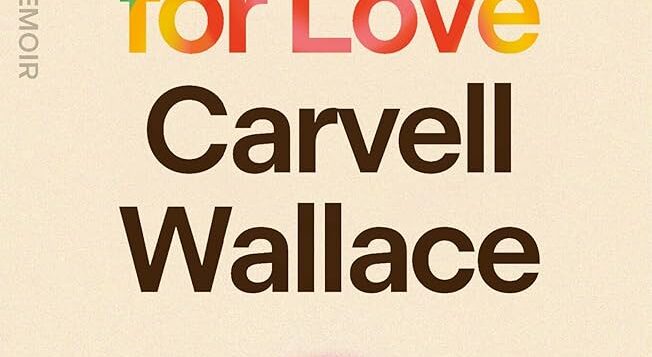 ANOTHER WORD FOR LOVE
ANOTHER WORD FOR LOVE
A Memoir
by Carvell Wallace
Farrar, Straus and Giroux.
272 pages, $28.
LIKE THE TOUGH, unruly childhood of its queer Black author, Another Word for Love isn’t easy to take in. Raised by a struggling single mother who twice gave him up to relatives, uneasy for decades about who he was, feeling small and anxious to please, using drugs and alcohol to numb his grief, Carvell Wallace nevertheless managed to forge a life of storytelling, parenting, connecting with people—and writing. Out of his intense experience, he has distilled a wide-ranging, compelling memoir full of insights from the vantage point of middle age.
Born in McKeesport, Pennsylvania, in 1974, Wallace lived in Virginia, Maryland, and California before moving to New York City to earn a BFA from the Tisch School of the Arts at NYU. He now lives in Oakland. Among his accomplishments are designing and running programs for troubled youth; writing noteworthy profiles for such publications as GQ, Esquire, Glamour, The New Yorker, and The New York Times; and producing Finding Fred, an award-winning documentary podcast about children’s television host Fred Rogers.
Another Word for Love unfolds in 35 loosely chronological episodes, but the title prompts an immediate question: What is that other word?
Wallace is sent back to McKeesport at the age of eight to live with his mother’s brother and his wife, an interracial couple. “The Clothes” describes the child rummaging through his aunt’s closet after school and pulling on her stockings: “When I looked in the mirror I saw a woman that I could be safe with who … knew everything about me and still wanted to spend time with me. That woman was me.” Caught and berated, Wallace quits dressing up. By eighth grade he is back living with his mother, but in Los Angeles, where he exults in the abundance of Black people and wins praise for high school drama performances.
“The Death” finds Wallace in his late twenties, married with two children and living in Oakland. He flies to Maryland to see his mother, who is dying of lung cancer. Amazingly, he has let go of resentment over her abandonments and brings her home with him. “To be among the dying, and to know it, the feeling that gives you, that is another word for love,” he says.
The trio of tales comprising Part Two, “Stories About God,” convey immanence rather than divinity. “The Moon,” for instance, is drawn from Wallace’s work leading nature trips for teenage boys formerly locked up for drug and violence offenses. On one such trip to Lost Coast in northern California, Wallace wakes to moonlight. Stepping past a clutch of sleeping youth he spies a huge boulder in nearby water, wades over to it, and stretches out. “The moon above me, the sea around me, me doing something weird by myself—three of my favorite things, the complete personal trifecta,” he recalls. Having fallen asleep, he wakes up drenched when the tide turns and then has to drag a soggy sleeping bag back to camp and recount the story. Later, he mulls over the situation. “To return, to be made whole again. That is another word for love,” he concludes.
The “Stories About Return” of Part Three disclose striking personal journeys. In “The Stars,” for example, Wallace reflects on Black history from the perspective of his own ancestry. His mother was the youngest of nineteen children born to his grandmother, Luvonia Mitchell. “It is her face that I have,” he notes. “My mother had it, and my children have some version of it … and it makes me feel we are of the same clan, the People of the Round Noses and Cheeks.” Two of the writer’s great-grandparents were born just before and soon after the end of slavery. “How did those round faces look gazing upward at the stars?” he wonders. “How did they make sense of their bondage?”
The memoirist seeks out living relatives too. Addicted to drugs and alcohol since college, he goes “cold sober” in his late thirties after visiting an aunt afflicted with alcoholism. Sobriety costs him his marriage, but Wallace remains on good terms with his wife and children, and he begins to get noticed for his writing—first on blogs, then for profiles in established publications. The writer is an intellectual who immerses himself in music. “The Bread,” for example, finds the writer baking a loaf while reading the letters of Audre Lorde and Pat Parker, as the album Stevie Wonder’s Journey Through “The Secret Life of Plants” (1979) pulses in the background.
“The Sex” and “The Touch” reveal more intimate adventures. In the first story, the author is “driving through SoCal with the top down,” on assignment for an interview. With time to spare, he has signed up for a Grindr hookup at a “gas station on the corner of Vine and Santa Monica,” where his date turns out to be in his fifties and wearing a stained shirt over tearaway warmup pants. The pants add sly humor to the episode, which ends with furtive sex abruptly interrupted when an SUV pulls up and disgorges an entire family, right next to Wallace’s car.
In “The Touch” the author recounts the thrill of being invited to a “queer and trans sex party” for people of color. Pressing his face close to another’s, he feels a sense of connection—but insists the exchange is not sexual. “A spirit? An essence? Hard to say,” he muses. “Maybe they just become a human in precisely the same way that you are human without the tiniest shard of separation between you … [and]your lips are not against their lips but against the eidolon of all of their being. … It’s the kind of thing where if you don’t pay close attention, you might miss it entirely. That moment … is another word for love.”
Rosemary Booth is a writer and photographer who lives in Cambridge, MA.






